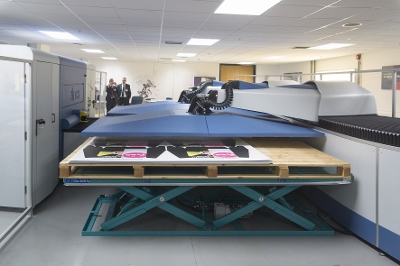The corrugated ‘three-quarters’ prototype in Broadstairs, seen here transferring a printed sheet from the Inca S40i printer to the delivery pallet, while a blank sheet is simultaneously picked up and transferred to the print bed.
Fujifilm is hoping to revolutionise the large format corrugated display board market with the introduction of an autoloader and modified UV inks to work with the Inca Onset high speed flatbed inkjet presses.
A robotic system has been developed to automate the loading and unloading of large format corrugated boards up to 3.14 x 1.6 metres in size. The system has been commissioned by Fujifilm, which markets the Inca printers worldwide. The first unit is running together with an Inca S40i press in a showroom at the Fujifilm Speciality Ink Systems site in Broadstairs, Kent. It is likely to be officially launched at the Fespa exhibition in London during June.
‘So far the corrugated market has not really moved from screen printing to digital,’ said Tudor Morgan, marketing manager. “It’s low margin work so not inevitably attractive for digital. However, digital simplifies the process. Onset printers are already used in many European companies for corrugated work. There are S70, S20 and S40 model, and two more in the USA. All were bought to complement existing screen and offset work, not to replace it.’
The new automated load/unload line can be fitted to existing Onsets, although if the original Inca system for display boards is already there, the corrugated line would have to replace it as both cannot be used together.
Large format corrugated is a particular challenge for automation as the boards are often curled and hard to feed by a mechanical system. Fuji solves the problem by keeping the board flat under constant vacuum, from the feed table to when it is dropped onto the delivery pallet.
The prototype system running at present is a ‘three quarters’ line, meaning that an operator has to manually load and align the sheets one by one onto a feed table next to the printer. After that the sheets are picked up by a very large suction frame that flattens them and moves them into exact position on the vacuum bed of the Onset printer, where the flatness is preserved, avoiding the danger of head strikes. The positional repeat accuracy is said to be 0.5 mm, which is very precise for this type of work.
At the same time as the blank sheet is moving over from the feed table, a second suction frame picks up the previous printed sheet from the bed and moves it over to a palette on a large stacking trolley on the other side of the printer. The cycle time between sheets is 20 seconds. Print time depends on the number of passes that the press makes, but is generally only a few seconds.
The bed travels inside the printer, under the heads and out again, in several passes to build up the quality, with a choice of gloss levels determined by the timing of the UV curing lamps. Fujifilm has altered the formulation of its Uvijet inks specifically for the needs of corrugated work, combining both flexibility and a wide gamut, it said.
As the stack builds up on the delivery side, hydraulics in the trolley drop the pallet so the top surface remains at the correct height for the unloading frame. When the stack is full the trolley can be wheeled away.
Beta testing of the corrugated system will start in March and the line will probably be ready for launch at the Fespa exhibition in June, said Mr Morgan. No price has been decided for the corrugated system, he added.
The next step, which he described as ‘long term,’ will be to complete the automation by placing a robot arm next to the feed table, replacing the need for manual loading from the pallet. This will have a third suction frame that will pick blank sheets up from the pallet and move them over to the feed table.

